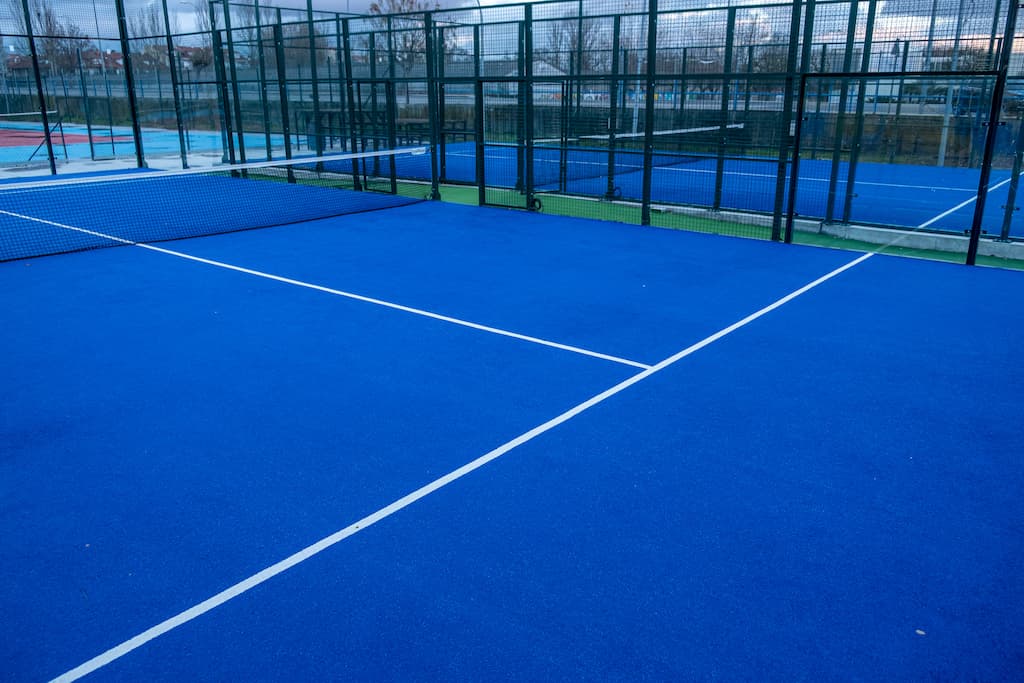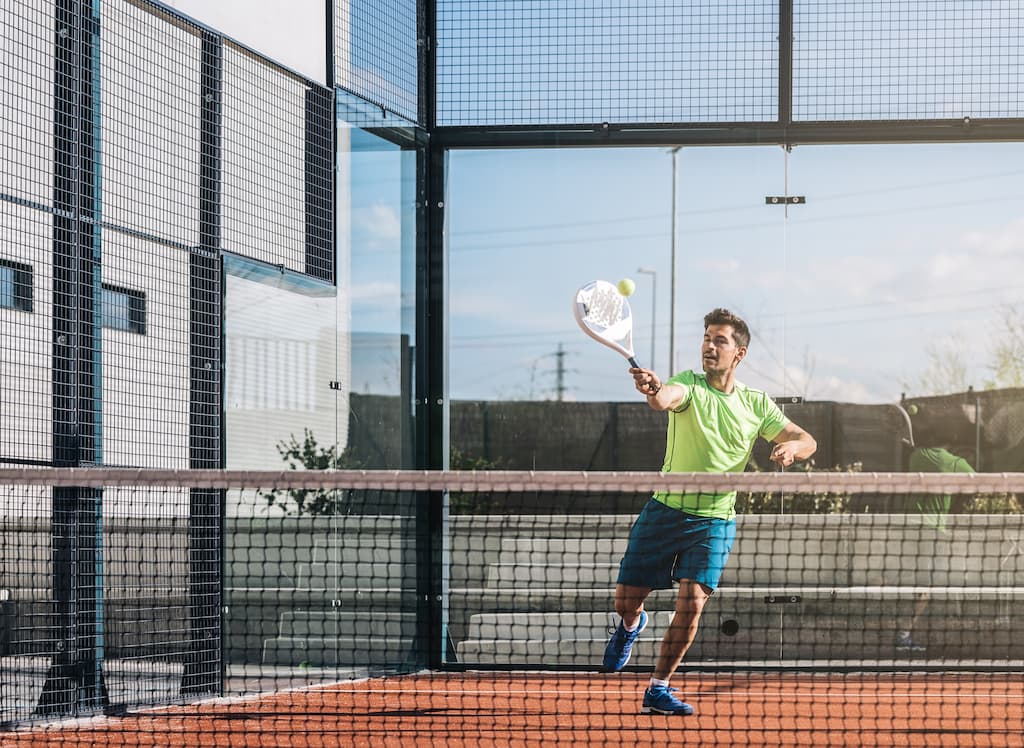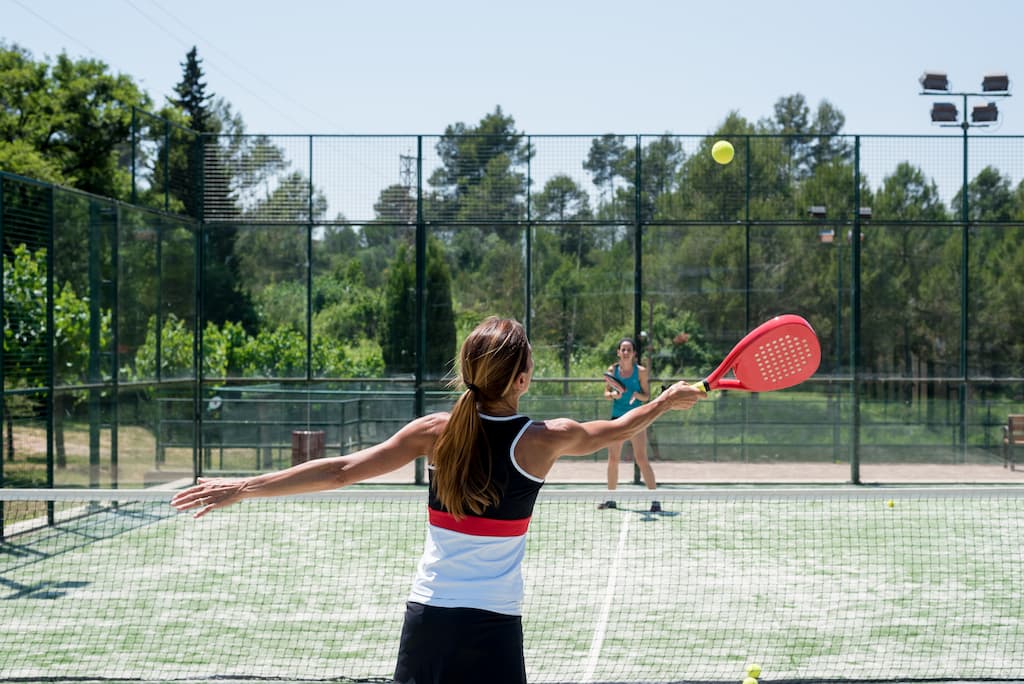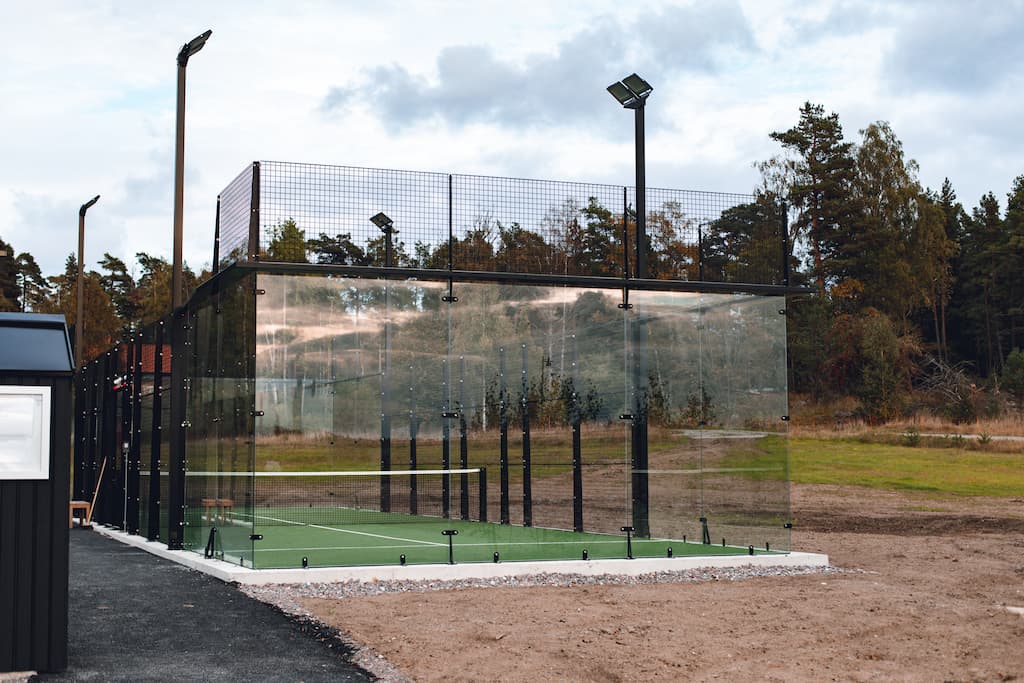If you are planning to build a Padel court at home or are just a curious newbie trying to get a grip on the game, it’s crucial to note that Padel courts can vary depending on whether you are indoors or outdoors. And these slight differences can impact your gameplay and the overall experience.
In this article, we’ll explore the differences between indoor and outdoor Padel courts to help you understand the game better and choose the best court that suits your preference. But before we dive into the main topic, let’s find out why Padel court dimensions are so important.
Padel Courts: Features and Dimensions of Indoor vs. Outdoor

A Padel tennis court, also called a “Padel court,” is the ground where the game of Padel tennis comes to life. Featuring glass walls and surrounding fences, the Padel court differs from traditional tennis courts in appearance and functionality. The encircling walls are not mere spectators but active participants in the game, serving as strategic allies for players to initiate rallies filled with unexpected bounces and clever moves.
Having established that the Padel court is different from tennis, the question is, are there any differences between indoor and outdoor Padel courts?
Well, in terms of features and dimensions, they are the same. The minor disparity between the two depends on a player’s preference.
The most significant difference between playing indoors vs. outdoors is the absence of external factors. You don’t have to worry about things like wind, heat, or even snow when indoors. Unfortunately, that’s not the situation when you’re on outdoor courts since they typically don’t have roofs.
While indoor courts have internal lighting installations, outdoor courts typically rely on natural daylight; hence, visibility can vary depending on the time of day and weather conditions. However, some outdoor courts may have electrical installations for evening play.
General Dimensions and Features of a Padel Court

According to the official regulations set forth by the International Padel Federation (FIP), the dimensions and specifications of a Padel court (indoor and outdoor courts) are as follows:
Court Dimensions
The Padel court must measure 20 meters in length by 10 meters in width, with a permissible tolerance of 0.5% in excess or deficit. This rectangular court is bisected by a net, positioned 6.95 meters from the service line.
Central Service Line
A perpendicular line, known as the central service line, divides the area between the net and the service line equally. The central service line extends 20 cm beyond the service line.
Court Halves
Both halves of the court must be identical in terms of area and horizontal markings. All lines on the court should be 5 cm wide.
Net Specifications
A Padel net is 10 meters long and stands at a height of 88 cm at its center. It can reach a maximum height of 92 cm at the lateral anchor points, with a permitted tolerance of up to 5 mm.
Net Poles
The external surfaces of the two net poles align with the lateral limits of the court, including the openings, doors, or metallic structures. And whether these poles take a circular or rectangular form, they must feature rounded edges.
Advantages and Disadvantages of Indoor vs. Outdoor Padel Courts

Indoor and outdoor Padel courts offer specific advantages, disadvantages, and playing experiences. Here’s a breakdown of the pros and cons of indoor and outdoor Padel courts:
Indoor Padel Courts:
Advantages:
Indoor courts provide a controlled environment, shielding players from adverse weather conditions like rain, wind, and extreme heat. This ensures that Padel can be played year-round regardless of the weather outside.
Moreover, indoor players are more protected and can enjoy Padel even during nighttime, extending the hours of play and making it more accessible for those with busy schedules.
The lighting system indoors also means that players can enjoy excellent visibility and gameplay regardless of the time of day.
Indoor courts typically require less maintenance since they are not exposed to harsh weather.
Disadvantages:
Some players also complain that indoor courts lack the natural ambiance they crave.
Outdoor Padel Courts:
Advantages:
Outdoor courts provide a more natural and open-air setting, allowing players to enjoy the beauty of nature while playing.
The exposure to a variety of weather conditions is one aspect of outdoor courts some players may dread. Still, some others enjoy it, as it adds an element of unpredictability and challenge to the game.
Outdoor Padel tennis courts also offer fresh air and a sense of spaciousness, which some players find invigorating.
Disadvantages:
- Outdoor courts are susceptible to weather-related disruptions, such as rainouts, extreme heat, or cold weather, which can limit playtime and require rescheduling.
- Outdoor courts may require more frequent maintenance due to exposure to harsh weather.
- Evening or nighttime play on outdoor courts may be determined by the availability and quality of external lighting.
What Do the Padel Professionals Prefer: Indoor or Outdoor Padel Courts?
The indoor vs. outdoor court preference depends on the individual, not necessarily the proficiency level. While some beginners may prefer or play comfortably outdoors, some hardcore, pro-level Padel champs may find it challenging to cope with the outdoor experience.
“When you play outdoors, you’ve got those wild winds messing up your serves, courts that double as slip ‘n slides, balls that feel more like wet sponges, and glass walls getting all misty-eyed – it’s like a sitcom of sporty mishaps!” Says Sean.
Walls and Back Walls

The court’s perimeter is enclosed partly by walls constructed of materials that provide a consistent ball rebound, such as glass or solid surfaces, and partly by wire netting (where rebounds are inconsistent). The back wall stands at a height of 4 meters, with the lower 3 meters being solid (transparent or opaque material) and the top meter closed by wire netting.
The lateral walls feature varying heights. The first section is 3 meters high by 2 meters long, while the second section measures 2 meters in height and 2 meters in length. The central part of the wall is then completed with metallic netting up to a height of 3 meters (height), totaling 16 meters in length and up to 4 meters in height at the two ends.
Wall Materials
Walls may be constructed from any transparent or opaque material, such as glass, brick, or plexiglass, provided they offer a consistent ball rebound, have a uniform finish, and guarantee player safety.
Wall Color
The walls should be of a single (uniform) color, preferably green, blue, or brown, but different from the court color. Glass-walled court materials need to stick to tempered glass standards.
Wall Netting
The metallic wall netting should be diamond- or square-shaped, with dimensions of the aperture not less than 5 cm nor greater than 7.08 cm.
Court Surface
The court floor can be made of concrete, wood, cement, or artificial turf, provided they ensure a consistent ball rebound. The court surface should be uniformly colored, distinct from the wall color, with green, blue, or brown tones preferred. Black is suitable only for internal installations.
Entrances
Court entrances may be located on one or both sides and must be symmetrical. They can feature one or two openings, either with or without doors. In the case of one opening, the minimum dimensions are 1.05 meters in width by 2 meters in height, with a maximum size of 2 meters by 2.2 meters. In the case of two openings, the minimum dimensions are 0.72 meters in width by 2 meters in height, with a maximum size of 1 meter by 2.2 meters.
Roof Limits
A clear space of at least 6 meters vertically from the court’s surface must be maintained, free from any obstructions. This applies to the roof or overhead beams for indoor courts and tree branches for outdoor courts. This rule applies to the placement of temporal installations like overhead cameras during World Padel Tour tournaments.
For new constructions, a recommended free height of 8 meters above the court’s entire surface is advised (also free from any objects).
Why are Court Dimensions Important?
A Padel court is an integral part of the Padel sport since it includes strict and precise dimensions determining most of the gaming experience. So, if you’re itching to become a Padel pro, understanding the correct Padel court dimensions is one of the fastest routes to playing this game like a champ! But how can the court dimensions affect your gameplay and strategies? Let’s find out!
How Padel Court Dimensions Affect Gameplay and Strategies
A traditional tennis court is significantly larger than a Padel court. The smaller court size in Padel encourages quick reflexes, close-quarter rallies, and an emphasis on teamwork. It also means less running and a shorter distance to hit the ball, making it easier for beginners to get started.
Moreover, the glass walls surrounding the court introduce an additional element to the game. Players can use the walls as part of their strategies to keep the ball in play, enabling creative shots and unpredictable angles.
Conclusion
The choice between indoor and outdoor Padel courts ultimately depends on your preference or perhaps the local weather conditions.
Indoor courts offer a secure, cozy environment and are suitable for year-round play, while outdoor courts provide a more natural setting but are influenced by external factors.
Both courts can be exciting and competitive for Padel enthusiasts, and players can adapt their skills to excel in either environment. But the most important takeaway is that whether you prefer the enclosed world of indoor Padel or the outdoor adventure, the joy of the game remains constant.
Frequently Asked Questions
Are There Padel Courts in the US?
Yes. According to the United States Padel Association (USPA), the country’s governing body for the sport, there are about 240 Padel courts in the US.
What is Padel Called in America?
Padel is still called Padel in America. Padel differs from paddle tennis because the former uses glasses and fences around the court, while the latter doesn’t.
The United States Padel Association hosted the Senior World Championships in March 2022, the first international Padel championship in the U.S.
Are There Different Sizes Padel Courts?
While the standard Padel court size, as recognized by FIP, is 10 meters wide and 20 meters long, the size of a single court for playing one-on-one remains 6 meters wide by 20 meters long. Padel courts for children (up to 6 years) measure 5 meters wide by 10 meters long.
Is Padel Court the Same Size as Tennis?
No, tennis courts are bigger than Padel courts. The tennis court measurements are 23.77m in length x 10.97m wide, while those of Padel courts are 20 meters long and 10 meters wide.
What are the dimensions of a single Padel court?
A single Padel court is measured 20 x 6. The length is 20 meters, and the width is 6 meters. The mesh height, crystal measurements, and other elements are the same.

